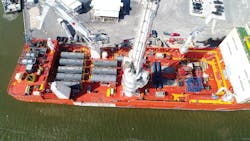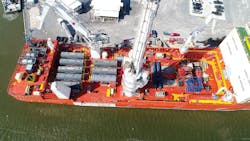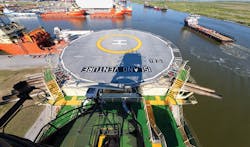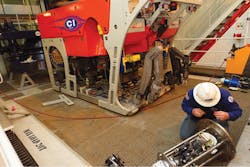Integrated approach to flowline remediation pays dividends
David Sheetz,C-Innovation
The requirement for large quantities of solvent meant that a large capacity vessel was needed for one flowline remediation project. (All images courtesy C-Innovation)
In its efforts to remain profitable, now more than ever, the oil and gas industry values the benefits delivered by a skilled workforce. Increasingly, operators are leaning toward a more turnkey approach to managing their business. By combining project management, engineering, procurement, service and personnel into a single source contract, they are seeking out more inclusive offerings at the same price structures. By uniting services and offering complete packages to the end user, a single contractor can maintain a higher utilization rate, enabling projects to be completed more efficiently than ever before.
As a member of the Edison Chouest Offshore group of companies (ECO), C-Innovation offers integrated ROV and vessel support services. By partnering with other ECO companies to harness the resources of a large vessel fleet, shipyards, port facilities and logistics and communications services, C-Innovation aims to offer a complete, economical solution to its clients, under one operating umbrella.
The following case studies describe the ways in which an integrated approach can improve the effectiveness of flowline remediation campaigns.
Case studies
One case involved a flowline asphaltene remediation job for a large international operator in the Mississippi Canyon area in the Gulf of Mexico. For this project, the client needed an effective one-stop-shop solution. The primary objective was to clear a flowline of an extensive asphaltene blockage, to satisfy the government’s decommissioning requirements.
There were a number of challenges. First, accessibility to the flowline was an issue. The asphaltene blockage was closer to the upstream/pipeline end termination (PLET) of the flowline, which was submerged under approximately 4,000 ft of water. The decision was therefore made to lift the flowline to the surface for surface injection of coiled tubing (CT) in order to reduce the total distance to the blockage.
The task of raising the flowline required lifting/threading through the moonpool of the vessel. An adequate hang-off structure to support the catenary weight (plus safety factors) was required, and a custom moonpool bridging system was designed and built by North American Shipbuilders (an Edison Chouest company) for this portion of the solution. Once recovered, a change-out of interface was required to allow for CT injection. An additional structure was needed to support the rig-up of a blowout preventer (BOP) and injector system and allow for safe workspace around the equipment.
In addition to these practical challenges, the full extent of the blockage was unknown. The flowline needed to be flushed to maintain cleanliness after the blockage remediation, which required service vessels at the tension leg platform (TLP) and the PLET. Large quantities of solvent were required and the anticipated volume of returns from the flowline required a large capacity of hazardous material storage and offloading to another vessel while onsite.
TheIsland Venture vessel was deployed to help recover and secure the flowline, so that the interface could be changed for intervention.
The downstream side of the flowline (on the TLP) required a temporary interface to the riser, and nitrogen packing and water flushing systems installed. The nitrogen packing was to provide positive indication of breakthrough on the solid blockage and the water pumping system was to flush the remediated flowline to regulatory cleanliness standards for decommissioning. However, there was only enough room on the platform for the temporary system, which directly interfaced with the riser. All other systems were deployed on a platform supply vessel (PSV) with a flexible hose connecting the systems on the TLP and the system on the PSV.
The C-Innovation Subsea Projects Group provided project management, engineering, offshore management, logistics and client relations/interface. TheIsland Venture was chartered for 26.16 days, with the preparation for this project beginning months in advance. The flowline was safely recovered and secured, and the interface was changed for intervention. The end of the flowline downstream of the blockage was packed with nitrogen. Asphaltenes blocking the flowline were removed, however not all were removed due to conditions that were more extreme than the client expected to encounter. The client decided to cease intervention after an approved period of time, and demobilize. The solution was deemed a success.
The crew and associated personnel had successfully achieved a task previously thought to be impossible: lifting a pipeline off of the seabed, and threading it through the moonpool of a vessel and supporting it for weeks while a surface intervention was performed. The client, impressed with this result, is now sole-sourcing a phase 2 solution through C-Innovation to continue to complete the work scope safely and without impact to the environment.
The second case involved opening an FS2 fluid loss isolation barrier valve using ROV power only. This work was undertaken for a large international operating company in the Gulf of Mexico.
With the drilling and completion rig already having moved offsite, there would have been a high cost and even higher impact to the remaining drilling and completion schedule to bring it back just to actuate this valve. A solution was developed to capitalize on and leverage existing infrastructure, to provide a new well intervention service to complete an essential task for production start-up. A procedure was developed that used an UHD ROV and related equipment to actuate the FS2 valve through existing tree communication ports. Existing ROV technology was employed to interface with an advanced subsea tree (XT) control system. Earlier generations of subsea control technology would require a more elaborate and expensive interface kit, but with cooperation from the client and subsea hardware companies, a more cost-effective solution was found.
C-Innovation employee performs maintenance on the ROV prior to the next operation.
C-Innovation designed, built and deployed a subsea tree controls interface system, which leverages the existing infrastructure and technology of the ROV systems. The interface system utilized 100% subsea ROV-based tooling to actuate the well’s lower completion isolation valve. The client required several wells to be opened. C-Innovation successfully actuated four FS2 valves to the open position using this system and the process improved with each well activation. Since the procedure had never been done before, there were some early calculations that were purely speculative. In the future, actuating the FS2 valve to create a fully functional tree can be completed in less than three hours.
Estimated cost savings were $3 million per well when compared to accomplishing the same with a rig and riser. The client considered the procedure to be a monumental success and a long-term solution to an otherwise costly endeavor. An additional option was created that will enable operators to start-up and commission their wells and fields at a lower cost, and also allows for more flexibility in logistics.
Conclusion
From these case studies, it can be seen that a combined, one-stop-shop approach to project management, engineering, procurement and service leads to greater savings and optimal solutions to the complex problems that are often encountered offshore. This approach is changing how the industry can respond to subsea equipment and well issues with existing technology and greater speed and still maintain reliability in control. Part of this effort is the on-going expansion of real-time monitoring of systems to prevent failures before they occur. With effective vessel monitoring in place, small changes in operational data (such as normal operating temperatures) can give early indications of problems that may lie ahead. A well-managed, proactive approach to vessel monitoring has the potential to further enhance ROV operations in the field and safeguard capital investments for the operator.



